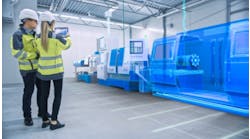Two years after COVID-19, taking stock of an altered manufacturing landscape
By Keith Higgins, vice president of digital transformation with Rockwell Automation
As COVID-19 created upheaval to businesses and industries across the globe, manufacturers responded with heavy investment in technology to tighten operations and adjust to supply chain disruptions created by the pandemic.
The results of this investment have been mixed: while this breakneck pace of adoption helped US manufacturing activity surge to a 37-year high, the challenge remains of filling more than half a million jobs, a hiring surge toward a full-capacity workforce that could add $1 trillion to the US economy by 2030.
Let’s explore how the manufacturing environment has changed—post-COVID—in some long-lasting ways.
Rapid technology adoption meets huge manufacturing challenges
Manufacturers impressively squeezed five years’ worth of innovation into just 18 months, a dizzying run that has created a slew of new industrial-technology use cases involving AI, IoT, digital supply chain, edge computing and other applications—helping manufacturers either preserve or drive growth over the past year and a half.
For example, implementing these technologies allowed organizations to create a digital thread to help connect business processes across an organization—from product and process design to operations—all with real-time insights to enable agile decision-making, accelerated innovation and increased quality and efficiency. A digital thread serves as a record of the evolution of an organization's entire operations—physical machines, manufacturing processes, automation code and maintenance steps—providing visibility into their past, present and future state.
Meanwhile, augmented reality (AR) revolutionized remote training for workers to adapt to travel restrictions and reskill workers for new operations to meet COVID-related demand for items like protective equipment and healthcare tools. Advancements in connected operations enabled new agility in equipment-monitoring and assessments; this helps manufacturers optimize their existing infrastructure, save on costs and be more agile in adjusting capabilities to meet shifting demand or supply chain conditions.
Supply chain use cases, overall, have been a huge focus of investment. Because of this, manufacturers found themselves better able to connect, automate, track and analyze their operations and supply chains. This helps counter ongoing problems caused by the pandemic such as long lead times, material shortages, rising prices and transportation difficulties.
Workforce implications
To minimize on-site occupancy and adhere to social-distancing mandates, manufacturers leveraged real-time analytics for remote monitoring, decreasing the number of employees needed on the factory floor to check machines and output without compromising on visibility of machine performance or health. Enterprises leveraging these real-time analytics can operate more safely and efficiently, ultimately driving improved productivity and data-driven optimization.
For all the benefits, these innovations have contributed to a highly altered landscape. One of the biggest shifts is the increased need for talent with the skillsets to work in more automated and flexible production environments. According to The Manufacturing Institute, some 70% of manufacturers say the biggest impact of robotics on the workforce in the next five years will be the need for more staff to engineer these robotics and their operating systems.
Attracting the next generation of workers with improved human-infrastructure applications is becoming a high priority for manufacturers.Fortunately, the advanced training tools leveraging AR and 3D-based work instructions enable workers to train with experts remotely. This is helping the manufacturing workforce stay connected and upskill as needed, despite lingering health impacts of the pandemic that could make in-person training sessions problematic.
Conclusion
These are just a few of the key considerations facing manufacturing leaders in a post-pandemic world. While the pace of technology adoption has been impressive, manufacturers cannot slow down and rest on their recent successes. Additional strategy and planning are required to fully leverage the benefits and minimize pitfalls. While striking this balance is easier said than done, the effort will better position manufacturers to adapt to disruption with accelerated innovation, maximized workforce productivity and optimized operations.



